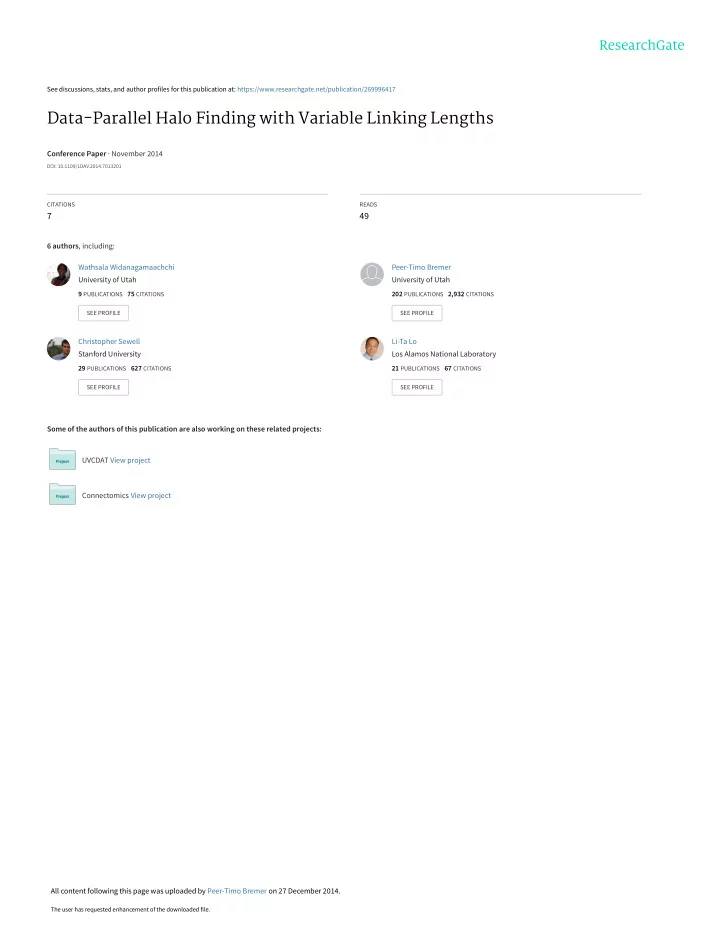

See discussions, stats, and author profiles for this publication at: https://www.researchgate.net/publication/269996417 Data-Parallel Halo Finding with Variable Linking Lengths Conference Paper · November 2014 DOI: 10.1109/LDAV.2014.7013201 CITATIONS READS 7 49 6 authors , including: Wathsala Widanagamaachchi Peer-Timo Bremer University of Utah University of Utah 9 PUBLICATIONS 75 CITATIONS 202 PUBLICATIONS 2,932 CITATIONS SEE PROFILE SEE PROFILE Christopher Sewell Li-Ta Lo Stanford University Los Alamos National Laboratory 29 PUBLICATIONS 627 CITATIONS 21 PUBLICATIONS 67 CITATIONS SEE PROFILE SEE PROFILE Some of the authors of this publication are also working on these related projects: UVCDAT View project Connectomics View project All content following this page was uploaded by Peer-Timo Bremer on 27 December 2014. The user has requested enhancement of the downloaded file.
14-23700 LA-UR- Approved for public release; distribution is unlimited. Title: Data-Parallel Halo Finding with Variable Linking Lengths Author(s): Wathsala Widanagamaachchi Peer-Timo Bremer Christopher Sewell Li-ta Lo James Ahrens Valerio Pascucci Intended for: IEEE Symposium on Large-Scale Data Analysis and Visualization, November 2014 Los Alamos National Laboratory, an affirmative action/equal opportunity employer, is operated by the Los Alamos National Security, LLC for the National Nuclear Security Administration of the U.S. Department of Energy under contract DE-AC52-06NA25396. By acceptance of this article, the publisher recognizes that the U.S. Government retains a nonexclusive, royalty-free license to publish or reproduce the published form of this contribution, or to allow others to do so, for U.S. Government purposes. Los Alamos National Laboratory requests that the publisher identify this article as work performed under the auspices of the U.S. Department of Energy. Los Alamos National Laboratory strongly supports academic freedom and a researcher’s right to publish; as an institution, however, the Laboratory does not endorse the viewpoint of a publication or guarantee its technical correctness. Form 836 (7/06)
Data-Parallel Halo Finding with Variable Linking Lengths Wathsala Widanagamaachchi ∗ Peer-Timo Bremer † Christopher Sewell ‡ SCI Institute, University of Utah SCI Institute, University of Utah Los Alamos National Laboratory Lawrence Livermore National Laboratory Valerio Pascucci � Li-Ta Lo § James Ahrens ¶ Los Alamos National Laboratory Los Alamos National Laboratory SCI Institute, University of Utah Figure 1: Halos found on a set of particles from a cosmological simulation: (a) Dataset contains 16.7 million dark matter particles. (b) Halos with linking length 0.2 and halo size 11. (c) Halos after increasing the linking length to 0.4141. Each set of particles in the same color in (b) and (c) represents a single halo. A BSTRACT to evolve a dark matter distribution from some initial near-uniform configuration, and these results are compared to observations. To State-of-the-art cosmological simulations regularly contain billions increase the fidelity of these models, ever more particles are used, of particles, providing scientists the opportunity to study the evo- and the state-of-the-art simulations often contain billions of dark lution of the Universe in great detail. However, the rate at which matter particles. However, analyzing these datasets is becoming these simulations generate data severely taxes existing analysis increasingly challenging and can require substantial computational techniques. Therefore, developing new scalable alternatives is es- resources. In particular, some of the baseline analyses, such as halo sential for continued scientific progress. Here, we present a data- finding, require new scalable alternatives to existing techniques. parallel, friends-of-friends halo finding algorithm that provides un- precedented flexibility in the analysis by extracting multiple linking Finding dark matter halos is a preliminary step to a wide range lengths. Even for a single linking length, it is as fast as the existing of analysis tasks. In this context, a “halo” [18, 10] is defined as an techniques, and is portable to multi-threaded many-core systems as over-dense region of dark matter particles and represents one of the well as co-processing resources. Our system is implemented using common features-of-interest. The two most common definitions of PISTON and is coupled to an interactive analysis environment used a halo are based on either a friends-of-friends (FOF) [7] clustering to study halos at different linking lengths and track their evolution or a spherical-overdensity (SO) measure [21]. The former com- over time. bines all particles that are reachable through links shorter than a predefined distance (the linking length ) to be in one halo, while the Index Terms: H.3 [INFORMATION STORAGE AND RE- SO method estimates the mean particle density and grows spherical TRIEVAL]: Information Search and Retrieval—Clustering; J.2 regions around local density maxima. While there exist other def- [PHYSICAL SCIENCES AND ENGINEERING]: Astronomy— initions, these are by and large derivatives or combinations of the two baseline approaches. Here, we concentrate on the FOF-based 1 I NTRODUCTION definition as it is less biased towards a particular shape and the pre- Modeling and understanding the evolution of the Universe is one of ferred technique of many scientists. the fundamental questions in cosmology. In particular, understand- To address a prior bottleneck, scientists at Los Alamos National ing how the observed, hierarchical distribution of dark matter forms Laboratory (LANL) in collaboration with the Hardware Acceler- is of significant interest. To explore different hypotheses, numerical ated Cosmology Codes (HACC) team developed a serial halo find- simulations based on different structure formation models are used ing algorithm [13, 26] that currently serves as the technique for ∗ e-mail: wathsy@sci.utah.edu per-node computation in HACC cosmology simulations. This al- † e-mail: bremer5@llnl.gov gorithm has also been included in the standard distributions of Par- ‡ e-mail: csewell@lanl.gov aview [12]. When simulated on a massively parallel machine, dark § e-mail: ollie@lanl.gov matter particles are distributed amongst the nodes using MPI with ¶ e-mail: ahrens@lanl.gov a sufficient overlap (the ghost zones ) such that any halo resides en- � e-mail: pascucci@sci.utah.edu tirely on at least one of the nodes. As a result the halo finding is typically performed first within a node followed by a clean-up to ensure each halo is recorded only once. Given a linking length, this algorithm reports all corresponding halos which are subsequently filtered by size. However, while there exists a default linking length,
Recommend
More recommend